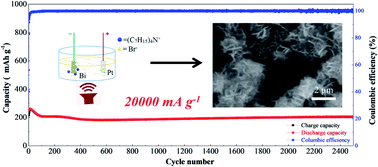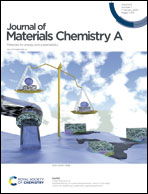Bismuthene from sonoelectrochemistry as a superior anode for potassium-ion batteries†
Abstract
Bismuth has a great potential as an anode for PIBs, due to its layered structure with a large interlayer spacing, long mean free path, high volumetric capacity (3800 mA h L−1) and environmental friendliness. Bismuthene, a 2D-layered structure, can be exfoliated from bismuth by mechanical or chemical methods. The unique structure of bismuthene is beneficial to the diffusion of potassium, penetration of the electrolyte, and buffering of the volume change along the c-axis, which will boost the anode performance of PIBs. An ultrasonication-assisted electrochemical exfoliation method was proposed in this study to prepare ultra-thin few layered bismuthene nanosheets (FBNs) simply and quickly. The as-prepared FBNs were employed in KIBs as an anode and delivered highly stable capacities of 423, 356, 275 and 227 mA h g−1 at the current densities of 2.5, 5, 10, and 15 A g−1, respectively. There was no obvious decay over 2500 cycles with a capacity of over 200 mA h g−1 at 20 A g−1, realizing excellent rate-capability and long-term cycling stability in KIBs. Furthermore, the mechanism of the excellent electrochemical performances was elucidated via in-depth characterization and theoretical calculations. This work provides a new strategy to prepare scalable ultra-thin nanosheets, which act as a promising candidate for the anode in energy storage systems.



 Please wait while we load your content...
Please wait while we load your content...